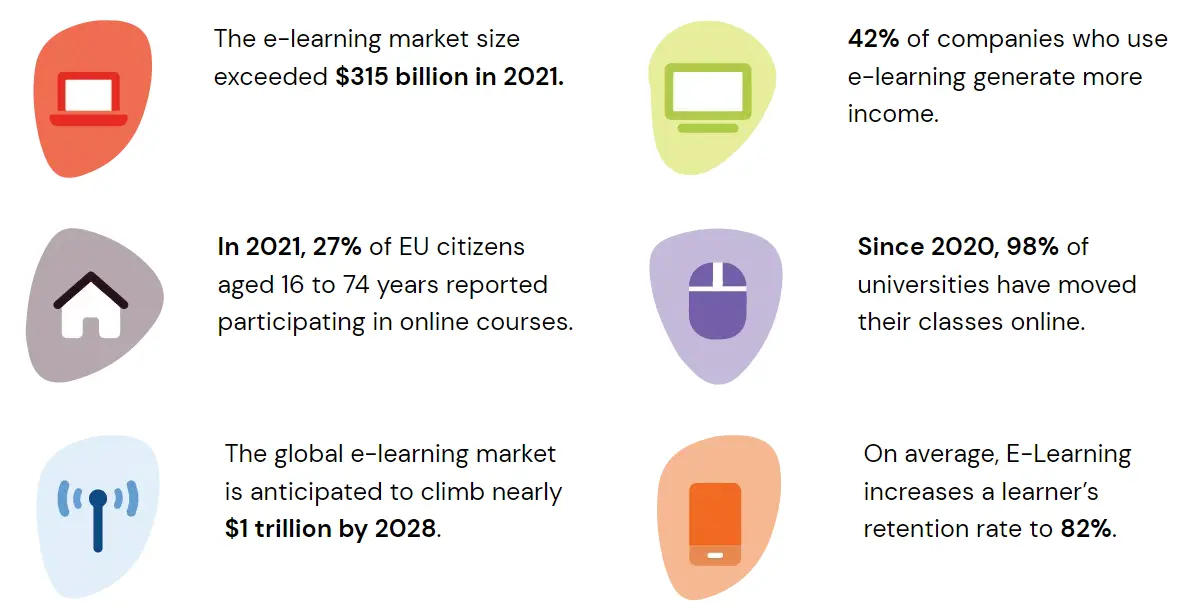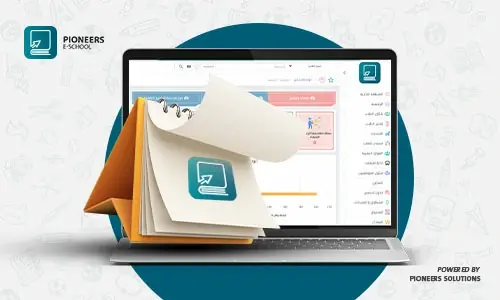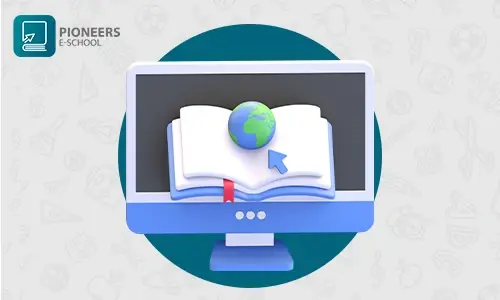Online learning (or distance learning) is one of the most widespread trends in the education field in recent years. This spread is attributed to the technological advances achieved in recent decades, which has led to an increase in the use of the Internet in daily life and changes in teaching and training methods.
The Internet has enabled the provision of a multimedia and flexible learning environment that allows educational content to be delivered directly, allowing learners to organize their time and schedules according to their personal needs, increasing the flexibility of the learning process and allowing students the opportunity to obtain different certificates and qualifications without the need to be present in a specific location or incur additional costs.
With the increasing use of distance learning in recent years, many online educational systems, e-learning technologies, and specialized programs have been developed to facilitate and improve the learning and distance education process.
In this article, we will learn about the concept of online learning, types of online learning, and its advantages and disadvantages.
What is online learning?
Online learning is a type of distance learning, where modern technology is used to provide an interactive learning environment online, which learners can benefit from to acquire knowledge, skills, and various certificates.
Online learning includes a range of educational activities, such as live lectures, educational videos, online group discussions, assignments and tests, and communication with teachers and learners online.
E-learning is considered a flexible and effective way to acquire knowledge and skills, as learners can study anywhere and at any time that suits them, and allows them to obtain different certificates and qualifications without the need to be in a specific place or incur additional costs.
Online learning also enables learners to benefit from modern technology and interact with teachers and learners through a variety of educational tools.
Statistics on the development of online learning
The most important statistics that demonstrate the extent of the development of online learning over the past years are:
- The size of the online learning market exceeded $315 billion in 2021.
- 98% of universities provided educational materials and training courses online in 2020.
- 42% of companies that provide interactive online courses for employees enjoy a higher return on investment.
- On average, e-learning increases learner retention rates to 82%.
- The Coursera e-learning platform recorded more than 20 million new learners on its training courses in 2021.
- The global e-learning market is expected to rise to $400 billion by 2026.

Types of online learning
Online learning can be classified into several types, including:
- Open educational courses:
These are open-source educational courses available to everyone online. They cover various topics in different fields such as science, technology, literature, arts, management, and languages.
- Online university education:
This type of education is offered through accredited university programs online. Lectures, assignments, exams, and communication with professors and colleagues are provided through e-learning platforms.
- Remote training:
This type of education involves providing training courses online, and educational content and interaction with trainers and colleagues are provided through e-learning platforms.
- Personalized online education:
This refers to providing lessons, lectures, and training courses on a personal and individual basis through specialized websites. Learners can learn at their own pace and at a time that suits them.
Advantages of online learning
Online learning offers many advantages, as learners can access educational materials from anywhere and at any time convenient for them, which provides flexibility and convenience in learning. They can customize and regulate the rate of learning to suit their abilities and needs, thus achieving the best learning outcomes.

- Available to anyone with an internet connection:
Since online courses are available to anyone with an internet connection, this has greatly helped to reduce the global education gap. It has also contributed to solving problems related to the number of students in one class, which is beneficial for both students and educational institutions.
Online classrooms make learning available to those who suffer from disabilities or mental delays. For example, deaf students can simply turn on closed captions (CC) to read the conversation and participate in the online class, and students who have difficulty reading can also choose to listen to audiobooks instead.
- Flexibility in learning:
One of the main benefits of online learning is the ability of students to attend classes from anywhere. This means that students in rural areas no longer waste their time commuting to attend classes. It also means that students with busy schedules can manage their time better and still attend classes.
- Low costs
Education can be expensive, but online learning can provide students with several ways to reduce expenses. Not having to go to campus can save transportation costs and living expenses.
Most online programs offered by educational institutions are eligible for financial support, and large learning management platforms like Udemy often issue coupons up to 90%. These discounts are not available in many universities and educational institutions, providing additional cost savings for students.
- Global connectivity
Online educational courses allow for connections with teachers and peers from all over the world. Before widespread availability of e-learning, you had to travel from country to country or from state to state to receive education. Now, you can join a European university and obtain a certified degree from your own home.
Online learning also allows you to communicate with people from different backgrounds and cultures, providing a different perspective and additional experience in communication.
- Career advancement opportunities
E-learning contributes to obtaining better jobs by providing opportunities to learn new skills and develop current ones, thus qualifying you to work in modern and advanced fields.
Online learning can also enhance your resume and make it more open and diverse. When you add e-learning courses to your resume, employees can see that you have taken the initiative to improve your skills and knowledge, making you stand out among other candidates.
- Customized Education
Customized education is one of the main advantages of online learning, where students can choose courses that fit their educational needs and the fields they want to work in the future. In other words, students can choose customized educational paths that fit their current levels and future needs, including academic, technical, business, administrative, humanistic, health sciences, and other courses.
Thanks to this flexibility, students can improve their skills and experiences and increase their opportunities to find better job opportunities. Students who want to change their career paths or invest in personal or professional development can also choose customized courses that meet their needs.
On the other hand, institutions and organizations can develop customized educational courses to train their employees and enhance their skills, thus enhancing productivity, efficiency, and effectiveness in the workplace. In addition, organizations and institutions can provide customized courses to groups of employees to provide the necessary training to complete work tasks effectively.
Disadvantages of online learning
Despite the many advantages of online learning, there are also some disadvantages that need to be taken into consideration.

- Lack of direct interaction between teachers and students:
One of the biggest problems facing online learning is the lack of direct interaction between teachers and students. When a student is in a traditional classroom, they can interact with the teacher directly and get immediate feedback on their questions and concerns. However, when a student learns online, communication with the teacher is limited to comments on emails or through chat rooms.
- Limited online student feedback:
In traditional classrooms, teachers can give students immediate feedback face-to-face. Students who are struggling with curriculum can solve problems quickly and directly during lectures or designated work hours. Personal feedback has a positive impact on students because it makes learning easier, richer, and more important.
- Online learning can cause social isolation:
Students who study through online learning may feel lonely and isolated, as they do not interact with their classmates in the classroom and feel disconnected from the class community. This can lead to discomfort, frustration, and can affect their performance in studies.
- Online learning requires strong self-motivation and time management skills.
The lack of self-motivation among students is still one of the main reasons for their failure to complete online courses. In traditional classrooms, there are many factors that constantly push students towards their educational goals.
- Heavy reliance on technology
Online learning requires the intensive use of technology, and therefore, it is greatly affected by technical glitches, internet connectivity issues, and software errors. This may lead to delays in submitting coursework and disrupt the learning process.
- Failure to develop students' communication skills online
It has been proven that online learning methods are highly effective in improving students' academic knowledge. However, developing communication skills for students is an area that is often overlooked during online lessons.
Due to the lack of face-to-face communication between peers, students, and teachers in an online environment, students may find themselves unable to work effectively in a team setting. Neglecting students' communication skills will inevitably lead to many graduates who excel in theoretical knowledge but fail to transfer their knowledge to others.
Conclusion
Online learning is growing in popularity today. Many traditional universities have started to offer their courses online for free. This represents an easy and convenient way to gain knowledge in almost all fields, from law and accounting to humanities, such as psychology, sociology, or history. Online learning is a great alternative to traditional universities, especially for those who do not have the time and money to enroll in physical courses.
Related Articles

2024-08-01
Mohamed Abdelsalam
Successfully closing the school year using Pioneers E-School
As the end of the school year approaches, private schools face many challenges in closing the school year and preparing for the new year. This process...

2024-01-24
Mohamed Abdelsalam
comprehensive guide use of technology in education
Technology is a set of tools and means that help a person improve his life and facilitate his work. Among the areas of use of technology, education is...





